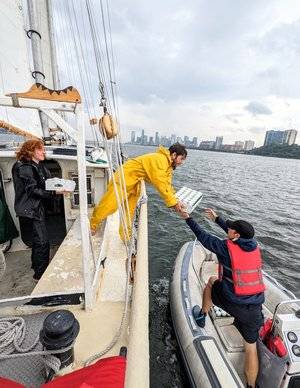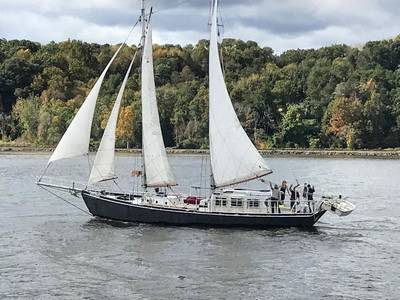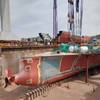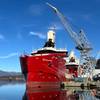Sail Freight: Fair Winds or Grassroot Sustainability?
Climate change advocates and seafarers recently gathered for a small conference at the Hudson Valley Maritime Museum in Kingston, N.Y., to discuss the shipping industry’s struggle to achieve sustainability and environmental compliance.
The setting, the hamlet of Rondout, N.Y. (within Kingston), holds significance as it was, ironically, a Hudson River port once considered the largest coal port in the world (yes, the world). In 1828, the opening of the Delaware and Hudson Canal enabled coal to be delivered from Pennsylvania to New York City. Sloops and Schooners made their way down the Hudson River by sail to deliver passengers, energy and agricultural cargo. With the development of the Rondout port came new industries and growth of the region’s rich agricultural resources. The success eventually built the city of Kingston.
Is this story simply a page out of New York maritime history, or is it something more? It may provide some lessons learned that are useful amid New York City’s present day marine highway struggles (as an aside, the current Maritime Administration Marine Highway program does not consider the Hudson River as a Marine Highway Corridor, despite the region’s maritime history).
According to Andy Willner of the Center for Post Carbon Logistics and the published Rondout Riverport 2040 plan, the past is teaching us about sustainable coastal transportation and a working waterfront. Today, Captain Sam Merrett and his crew of the Schooner Apallonia support the plan as they successfully deliver cargo on the Hudson River by sail freight and wind propulsion. We are discussing a post carbon future at this small conference, not history.
The recent event in Kingston was advertised as “The Conference on Small Scale Inland and Coastal Sail Freight”. Gavin Allwright, Secretary General of the International Windship Association was the keynote speaker. ISWA is an association with more than 150 members and a campaign designed to accelerate the adoption of wind propulsion in the form of primary or wind-assist/hybrid alternative propulsion, a blend of wind and alternative fuels to achieve decarburization of the global shipping fleet. IWSA reports an estimated 25 working commercial cargo vessels worldwide installing several types of sail propulsion technology.
There are recent examples of the ISWA effort. Installations of the WISAMO (Wing Sail & Mobility, an inflatable and automated wing sail by Michelin) on several larger RoRo vessels in Europe come with a prediction of a 20% reduction in energy and as a result a reduction in emissions.
Japan’s Mitsui OSK lines has completed its first voyage on the 100,000 deadweight ton bulk carrier Shofu Maru employing their Wind Challenger concept, a 170-foot sail designed and installed with Oshima shipyard in a research program under development for over a decade.
Other sail manufacturers are looking to assist with propulsion and claim similar energy savings. Interest in sail assist is building as an effort toward achieving the IMO short-term measures of reducing carbon intensity by 40% by 2030. Sail assist is growing in popularity worldwide.
That said, the discussions during the day at this conference were best described as pure and passionate. This was not sail assist innovation to reduce the daily fuel consumption of a vessel. Nor was the debate to work toward sharing the transportation space with fossil fuel propulsion. The goal of this community is to look to the past for solutions to fuel the future. And they believe in no uncertain terms that the region is ready for sail freight, the Schooner Apellonia being the current platform to prove it can be successful. They supported the statement with panels and guests that followed the opening keynote.
Steve Woods, Education Coordinator of the Hudson Valley River Museum and author of several publications on sail freight, discussed actual sail freighter operation, tidal influence, docking and undocking. References and training requirements selected from the material he has developed and published in the “Sail Freighter Handbook” and “Sail Freight Revival”.
Captain Tanya Van Renesse continued with a spirited presentation addressing diversity, equity and inclusion (DEI) in the maritime workplace. As the master of the river tour boat Solaris, Captain Van Renesse spoke to the job opportunities for women, racial equality at sea and her experience as a crewmember aboard the Appollonia. The takeaway is that the growth of sail freight can also help to solve the maritime DEI issue by simply never letting it take place in the reviving windjammer fleet. Supporters of sail freight believe that many of the skills needed to develop this transportation system have been lost and training of those new crews and captains will include everyone willing to hoist the sail.
A brief confession as I write this piece and accepted the invitation to the conference: I was raised along the Hudson River in the Mid Hudson Valley, and I worked tugs and barges from Albany to New York early in my maritime career, following my father who was a purser on the Circle Line cruises as a kid in the Bronx.
My company Amtech, with our sister company First Harvest Navigation, is working to support family farms in New York and New England using zero emission, lithium powered catamarans in Long Island Sound and Connecticut. As a result of our operation, many of the farms and manufacturers in the Mid Hudson Valley have asked us to look at a Hudson River itinerary into New York City. There is definite karma and synergy in the valley when it comes to gathering a group to discuss climate change action in transportation. The question becomes will history follow technology or will technology follow history? The answer to that question might be both.
In looking at the end of working sail on the Hudson River, there was a large window in the late 19th century where steam and sail co-existed. In the future, as we reach for zero emissions, we may see something similar with schooners tied up next to modern hybrid vessels digitally coordinating cargo movements—a polytechnic environment that allows the best selection of technologies for the purpose at hand, rather than relying on just trucking.
As the past chairman of the Maritime Administration Short Sea Shipping Cooperative, nearly 15 years ago we learned one of the most important issues to create successful coastal and last mile transportation. Peter Shaerf, former Vice Chairman of SCOOP, tagged it “Cargo is King”.
And with that thought, Brad Vogel introduced himself as the Apollonia’s Supercargo and discussed the Hudson Valley’s producers and consumers caring about the environmental impact of their products and their new connection to the river. These artisans and farmers range growers of rye and barley for malt and hops to serve craft breweries and distilleries, to makers of maple syrup, hot sauce and mushrooms. These are shelf stable, loaded and discharged break bulk at more than a dozen ports from Albany to Staten Island. Most if not all of these customers are looking to solve their transportation dependency on fossil fuels and work toward complete sustainability in their product line. The group believes the Hudson River is the place to demonstrate this sustainability model connecting upstate producers to one of the world's largest markets down river in the New York Metropolitan area. We agree and we hope to work with the Appollonia to add a second level of zero emission technology, refrigeration and direct schedules where needed to grow the cargo support.
I remember as a kid when Pete Seeger sailed the river on the Clearwater preaching environmental stewardship at a time when the pollution prevented us from being able to fish the river. The river has proven resilient and capable of revival with the support of river communities reinvesting in their waterfronts. LTL and global logistics are reporting a downturn following the delays and disruptions that occurred on the West Coast ports of the United States during the COVID pandemic. Amazon is reporting massive layoffs, FedEx furloughing drivers due to a decrease in consumer activity. There is evidence of a renewed interest in local manufacturing and family farm production. In no uncertain terms, this collection of Mid Hudson valley advocates is ready to support those efforts, wherever the wind blows.
 (Photo: Hudson River Maritime Museum)
(Photo: Hudson River Maritime Museum)

















